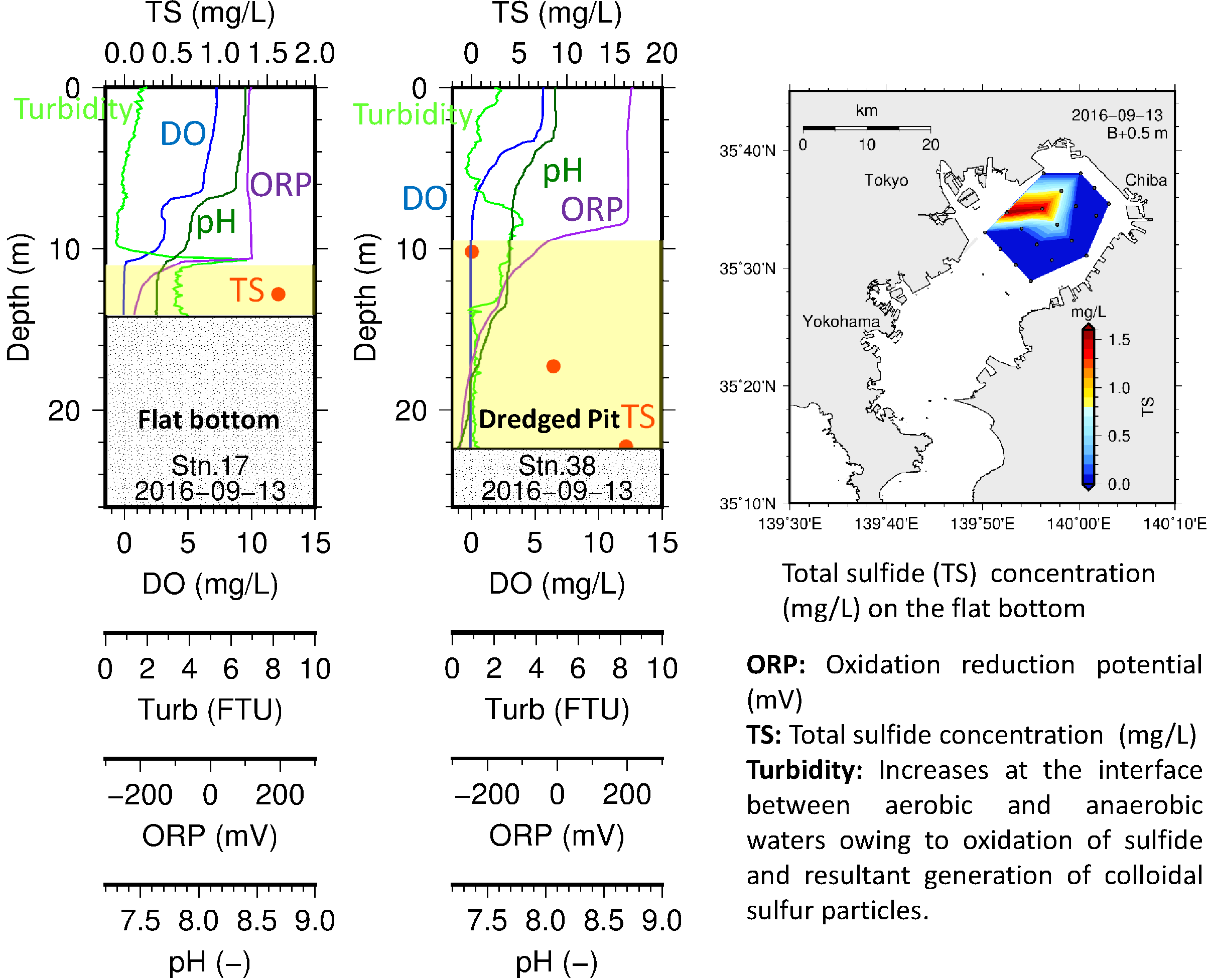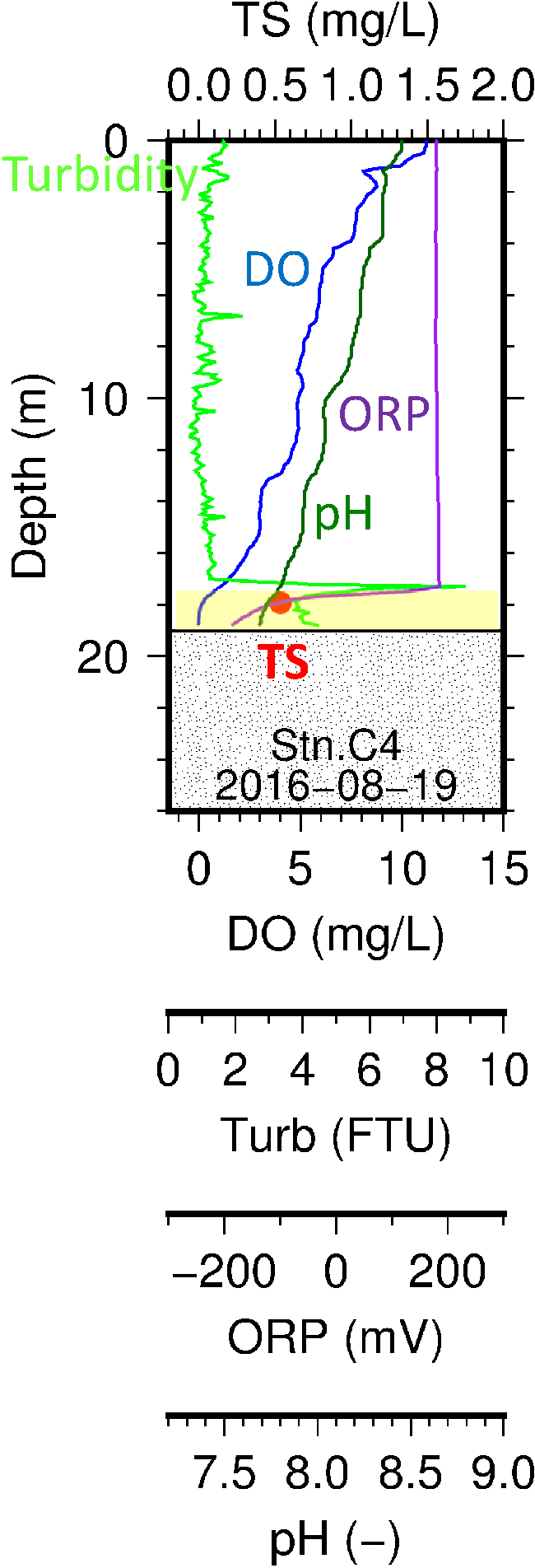Hypoxia and anoxia in Tokyo Bay
In the bottom layer of Tokyo Bay, a large scale of oxygen depleted water mass (water mass with dissolved oxygen concentration (DO) of around 3 mg/L or less) appears in summer. The water mass completely lost oxygen (DO = 0 mg/L) is called anoxic water mass, but in a broad sense the anoxic water mass is included in the hypoxic water mass. It is difficult for fish and shellfish to inhabit in hypoxic water environments, leading to mortality of them. Therefore, in Tokyo Bay, the occurrence of hypoxia and anoxia is considered the most serious water quality issue.
Appearance of anoxia and hydrogen sulfide
In sediments under anoxic water mass, sulfate reduction bacteria using sulfate ions for respiration instead of oxygen proliferate and generate sulfide. Sulfide ion reacts (oxidizes) with oxygen when available to form colloidal sulfur particles. Hydrogen sulfide, a form of sulfide, is also highly toxic. If the anoxic water mass containing this sulfide upwells (rises up to the surface layer) due to a wind induced current caused by the northeastern wind, the "blue tide" where the water surface becomes pale and white occurs in the surface water. Blue tide water is not only oxygen-free, but also contains sulfide, so it is toxic, and sulfide also consumes oxygen, resulting in the hypoxia lasting for a long time. Therefore, if the blue tide water intrudes into tidal flats or shallow water areas, it may cause mass death of benthic animals, including clams. Sanbanze surrounded by Urayasu City, Ichikawa City and Funabashi City is a precious tideland and shallow water area remaining at the head of the bay, which is also one of the important fishing grounds especially for short-necked clams and seaweeds in the bay. The occurrences of a large scale of blue tide, however, leads to significant decline in fish catch once in several years.
Efforts to improve hypoxia and anoxia by implementation of total pollutant load control system (TPLCS)
Development of oxygen depleted water mass and resultant mortality of fish and shellfish as well as degradation of material circulation are considered to be the most serious problem on water quality for many years. The total pollutant load control system has been implemented on chemical oxygen demand (COD), an indicator of organic matter concentration, since 1980, and on total nitrogen (TN) and total phosphorus (TP) since 2001. As a result, the pollutant loads of COD, TN, and TP has decreased by half to one third, and improvements in water quality in general have been observed. However, there is almost no indication of improvement in the hypxia and anoxia problem.
Necessity for monitoring of anoxic water mass
In this situation, we believe that the initial goal is to reduce the amount of anoxic water mass containing sulfides, and to improve it to a water mass containing oxygen to some extent. Thus, it is necessary to perform monitoring of anoxia and clarify where and how the anoxic waters containing sulfide are originally generated along with their scales, which findings will be useful to consider possible measures and their effectiveness. In order to capture the decrease in sulfide concentration and the reduction of anoxic water mass, which are supposed to be the first symptom of improvement of water quality. Although monitoring of sulfide has not been implemented in the water quality measurement for public waters, it must be very significant for implementation, evaluation and validation of environmental restoration projects.

Figure 1 Bathymetry in Tokyo Bay (left) and zoomed bathymetry around a dredged pit off Makuhari along with a vertical sectional view of sea bottom along the inspection line.
Field observation on the sources of anoxic waters and their influence on blue tide
We have involved in monitoring of spatiotemporal distribution of DO and sulfide concentration in the inner part of Tokyo Bay and clarifying the source of major anoxic water masses and their influence on blue tide.

Figure 2 Spatial variation in sulfide concentration at the bottom layer on flat bottom (right), and vertical profiles of water quality at flat bottom (left) and at off-Makuhari dredged pit (middle), in inner part of Tokyo Bay.
The left and middle graphs in Figure 2 show vertical profiles of water quality in early autumn at a flat bottom and off-Makuhari dreged pit in innter part of Tokyo Bay. The yellow-colored hatched areas show anoxic waters where dissolved oxygen concentration (DO) is zero and total sulfide (TS) is generated as well as ORP takes negative values. At the interface between oxic and anoxic layers, turbidity becomes high, which indicates the generation of colloidal surfer particles owing to the oxidation of sulfide. Total sulfide appears intermittently on the flat bottom while it has been accumulated and always appear with high concentration in the dredged pit.
The right-hand side panel in Figure 2 shows spatial variation in sulfide concentration at the flat bottom on the same date covering from Tokyo Port to off-Urayasu. The hypoxic and anoxic waters are dynamically moving in inner part of the bay forced by wind-induced, density-induced and tidal induced currents. Chiba Prefecture Fisheries Research Center developed a nowcast/forecast system for hypoxia and anoxia and providing information about spatial and temporal variation in DO in the bay on its web site (Ishii et al., 2011).

Figure 3 Vertical profiles of water quality in Chiba navigation channel in summer
There exit several navigation channels for large vessels in the bay. The scales of Funabashi and Chiba navigation channels are large, which channels were dredged deeply below the flat bottom. Port areas, including Chiba Port and Funabashi Port, were also dredged where their water quality has been degraded Figure 3 depicts vertical profiles of water quality in the Chiba navigation channel in summer, showing the appearance of bottom anoxic water. The navigation channels are also considered pathways for hypoxic and anoxic waters on the flat bottom moving to the bay head.
References
- Amunugama, M. and Sasaki, J.: Numerical modeling of long-term biogeochemical processes and its application to sedimentary bed formation in Tokyo Bay, Water, 10(5), 572, 2018. DOI
- Sasaki, J., Kanayama, S., Nakase, K., and Kino, S.: Effective application of mechanical circulator for reducing hypoxia in an estuarine trench. Coastal Eng. J., 51(4), 309-339, 2009.
- Sato, F., Sasaki, J., Sano, H., O, H.: Spatial and temporal characteristics of and numerical reproduction of anoxic water at the head of Tokyo Bay, J. JSCE B2 (Coastal Eng.), 71(2), I_1267-I_1272, 2015.DOI
- Ishii, M., Furukawa, K., Sasaki, J. Kakino, J.,Matsuda, S., Komori, A., Momoi, M. and Aso, A.: A methodology for application of a nowcast/forecast system bottom layer dissolved oxygen (DO) to fisheries in Tokyo Bay, J. JSCE B2 (Coastal Eng.), 67(2), I_1236-I_1240,2011.DOI
